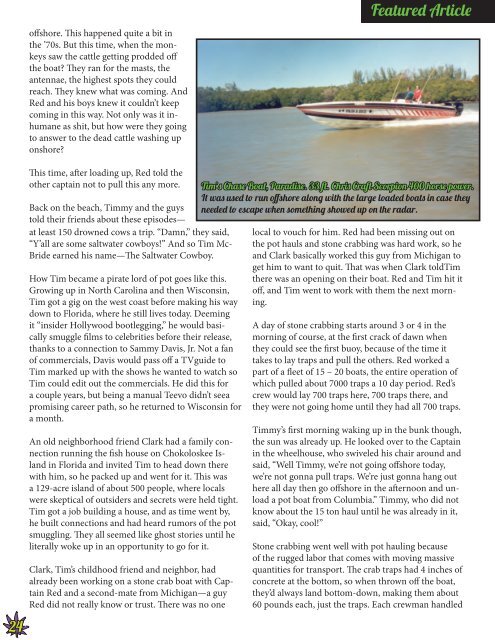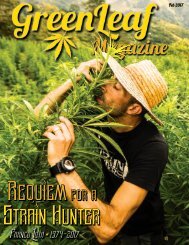Create successful ePaper yourself
Turn your PDF publications into a flip-book with our unique Google optimized e-Paper software.
Featured Article<br />
J24<br />
offshore. This happened quite a bit in<br />
the ’70s. But this time, when the monkeys<br />
saw the cattle getting prodded off<br />
the boat? They ran for the masts, the<br />
antennae, the highest spots they could<br />
reach. They knew what was coming. And<br />
Red and his boys knew it couldn’t keep<br />
coming in this way. Not only was it inhumane<br />
as shit, but how were they going<br />
to answer to the dead cattle washing up<br />
onshore?<br />
This time, after loading up, Red told the<br />
other captain not to pull this any more.<br />
Back on the beach, Timmy and the guys<br />
told their friends about these episodes—<br />
at least 150 drowned cows a trip. “Damn,” they said,<br />
“Y’all are some saltwater cowboys!” And so Tim Mc-<br />
Bride earned his name—The Saltwater Cowboy.<br />
How Tim became a pirate lord of pot goes like this.<br />
Growing up in North Carolina and then Wisconsin,<br />
Tim got a gig on the west coast before making his way<br />
down to Florida, where he still lives today. Deeming<br />
it “insider Hollywood bootlegging,” he would basically<br />
smuggle films to celebrities before their release,<br />
thanks to a connection to Sammy Davis, Jr. Not a fan<br />
of commercials, Davis would pass off a TVguide to<br />
Tim marked up with the shows he wanted to watch so<br />
Tim could edit out the commercials. He did this for<br />
a couple years, but being a manual Teevo didn’t seea<br />
promising career path, so he returned to Wisconsin for<br />
a month.<br />
An old neighborhood friend Clark had a family connection<br />
running the fish house on Chokoloskee Island<br />
in Florida and invited Tim to head down there<br />
with him, so he packed up and went for it. This was<br />
a 129-acre island of about 500 people, where locals<br />
were skeptical of outsiders and secrets were held tight.<br />
Tim got a job building a house, and as time went by,<br />
he built connections and had heard rumors of the pot<br />
smuggling. They all seemed like ghost stories until he<br />
literally woke up in an opportunity to go for it.<br />
Clark, Tim’s childhood friend and neighbor, had<br />
already been working on a stone crab boat with Captain<br />
Red and a second-mate from Michigan—a guy<br />
Red did not really know or trust. There was no one<br />
Tim’s Chase Boat, Paradise. 33 ft. Chris Craft Scorpion 400 horse power.<br />
It was used to run offshore along with the large loaded boats in case they<br />
needed to escape when something showed up on the radar.<br />
local to vouch for him. Red had been missing out on<br />
the pot hauls and stone crabbing was hard work, so he<br />
and Clark basically worked this guy from Michigan to<br />
get him to want to quit. That was when Clark toldTim<br />
there was an opening on their boat. Red and Tim hit it<br />
off, and Tim went to work with them the next morning.<br />
A day of stone crabbing starts around 3 or 4 in the<br />
morning of course, at the first crack of dawn when<br />
they could see the first buoy, because of the time it<br />
takes to lay traps and pull the others. Red worked a<br />
part of a fleet of 15 – 20 boats, the entire operation of<br />
which pulled about 7000 traps a 10 day period. Red’s<br />
crew would lay 700 traps here, 700 traps there, and<br />
they were not going home until they had all 700 traps.<br />
Timmy’s first morning waking up in the bunk though,<br />
the sun was already up. He looked over to the Captain<br />
in the wheelhouse, who swiveled his chair around and<br />
said, “Well Timmy, we’re not going offshore today,<br />
we’re not gonna pull traps. We’re just gonna hang out<br />
here all day then go offshore in the afternoon and unload<br />
a pot boat from Columbia.” Timmy, who did not<br />
know about the 15 ton haul until he was already in it,<br />
said, “Okay, cool!”<br />
Stone crabbing went well with pot hauling because<br />
of the rugged labor that comes with moving massive<br />
quantities for transport. The crab traps had 4 inches of<br />
concrete at the bottom, so when thrown off the boat,<br />
they’d always land bottom-down, making them about<br />
60 pounds each, just the traps. Each crewman handled






